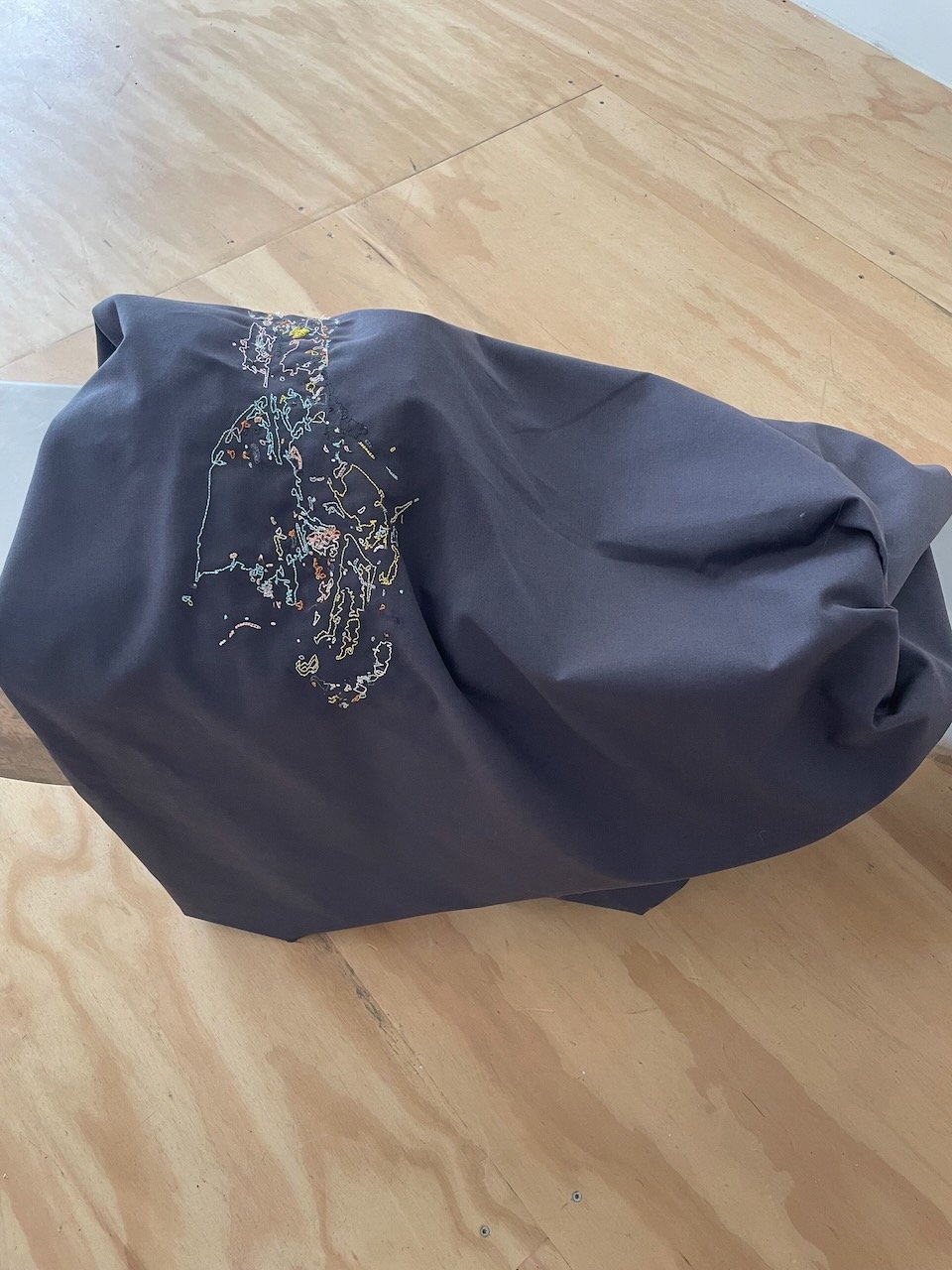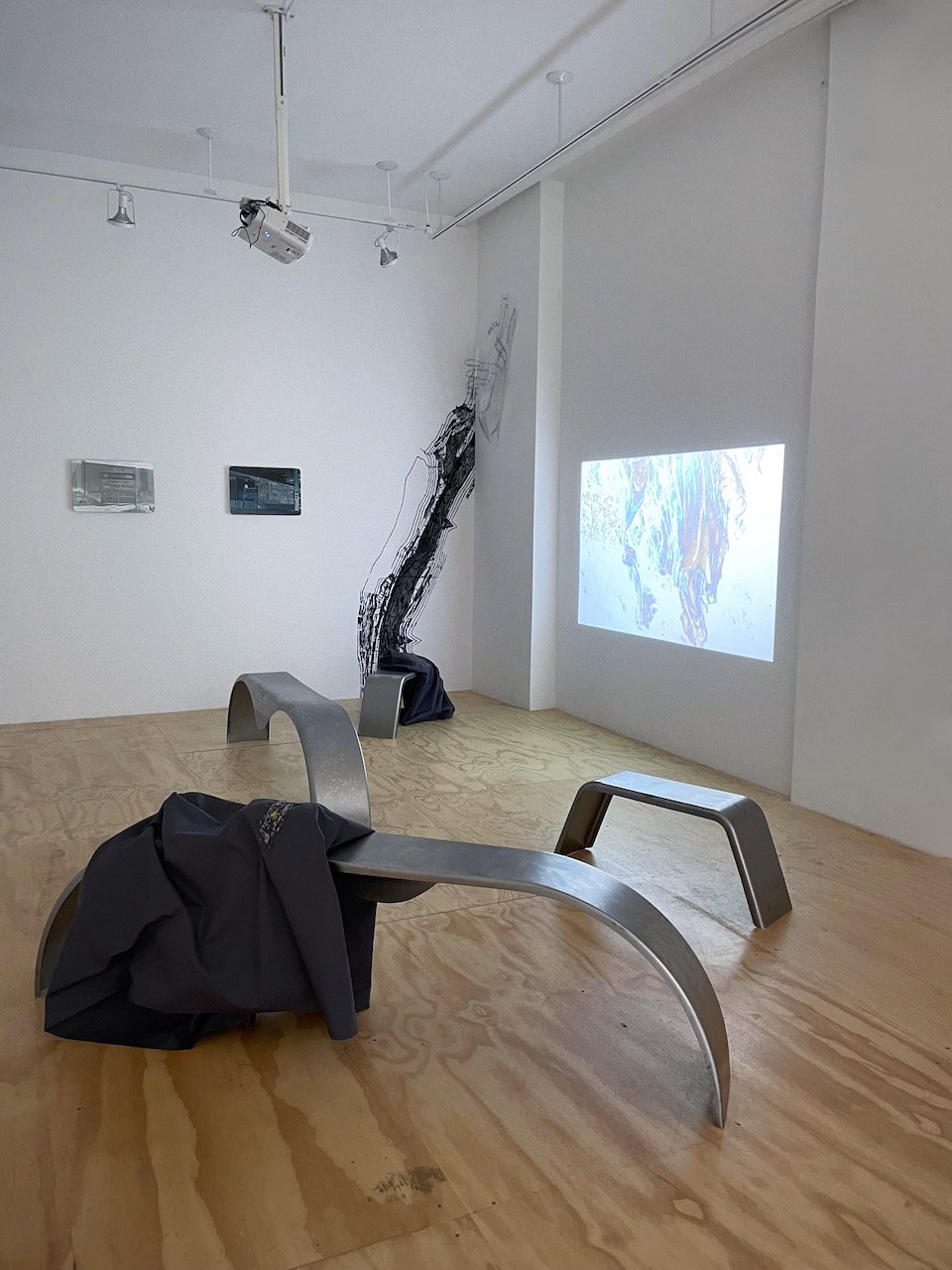Fia Backström
The Great Society

Fia Backström, 5049 Days Without Lost Time Accident, Coronado Mines Construction Crew, Nov 12, 2023, 2024. (Ed. 1 of 3), UV print on powder-coated steel.
“I know in America there are songs, forgetful ballads to be sung”
— Muriel Ruykeiser, The Book of the Dead, 1930
Brief Histories presents The Great Society by Fia Backström, opening May 11, 2024 and on view through June 22, 2024. This new body of work investigates ways of thinking through issues of class, race, labor, and their entwinement with environmental degradation. Backström uses photographs as empirical data to implement a working process that includes engineering drawings, quantitative working days, and embroidery and printing computational production methods.
The Great Society takes as its point of departure the historic sites and coal mines around Buffalo Creek, West Virginia. On February 26, 1972, a coal slurry dam broke and buried the coal camps lining Buffalo Creek, killing hundreds, making thousands homeless, and the land toxic. The mining company blamed God’s hand while the community became the study subject of psychiatrists working on collective trauma. Just up the mountain is Blair Mountain mine, where in 1921, the largest labor uprising in US history had 10,000 coal miners protesting, soon restrained by federal law enforcement who dropped bombs on them. ‘The Great Society’, a 1960s national political vision aimed at eradicating poverty and racial injustice, stands in contrast to a statement by the then U.S. president who coined it: if you can convince the lowest white man he's better than the best colored man, he won't notice you're picking his pocket. This well known perpetuated conflict of race and class continues today in comments on baskets of deplorables and blood contamination. According to Backström, this zone of deep extraction functions much like a repressed unconscious, a colony within, onto which projections of backwardness, stupidity, and trash abound. The folded architecture of the mine, beyond its heavily surveilled exteriors, descending into the fossilized darkness of ancient woods, now carbonized, shapes spaces for resistance and alternative communal care.
Backström has been returning to Buffalo Creek since 2017 in search of a photographic ethic. Working within these folded spaces of resistance, she uses photographic digital and analog techniques, producing textural prints that explore the thresholds of the visible. Stressing and stretching the histogram of her photographs, Backström inverts them to create negative space for another vision. She varies this technique by partially washing away the coal dust ink of the cartridges off the transparencies. Included in the exhibition is Days Without Lost Time Accident (2024), a set of photographs of signs outside of the mines lining Buffalo Creek, which quantify injured bodies against efficiency. These photographs punctuate a reproduction of a geological map of Buffalo Creek, first produced in the 1970’s by government-hired engineers for the court hearings after the disaster. Backström’s video essay, The Mud Wave (2024), accompanies the photographs, with truck fenders as seating, pointing to the steady stream of trucks carrying coal. Backström will be present in the gallery intermittently throughout the exhibition to continue an ongoing embroidery process she initiated alongside members of the Buffalo Creek community.
Fia Backström (b. 1970, Sweden, lives in New York). Working in diverse mediums including photography, writing, installation, and performance, Backström agitates the social life of language and materials. Her practice maintains a longstanding inquiry into the glue of collectivity. Recent projects include The last of US—that safe space above I in the word life at the Kitchen, New York (2022) and Facing Her Land - notes from elsewhere, Thielska Museum, Stockholm (2019). She has participated in group exhibitions at Greater New York MoMA/PS1 (2015), MoMA (2010), the Whitney Biennial (2008), Moderna Museet, Stockholm (2010). Backström was the subject of a survey at the Artist’s Institute 2015 and represented Sweden in the Venice Biennale 2011. Her work is in the collections of Moderna Museet and the Whitney Museum.
The Great Society by Fia Backström is on view from May 11, 2024, through June 22, 2024. Brief Histories viewing hours are Thursday to Saturday 12pm–6pm

Fia Backström, The Great Society at Brief Histories, New York, 2024.

Fia Backström, The Great Society at Brief Histories, New York, 2024.

Fia Backström, The Great Society at Brief Histories, New York, 2024.

Fia Backström, The Great Society at Brief Histories, New York, 2024.

Fia Backström, The Great Society at Brief Histories, New York, 2024.

Fia Backström, The Great Society at Brief Histories, New York, 2024.

Fia Backström, The Great Society at Brief Histories, New York, 2024.

Fia Backström, The Great Society at Brief Histories, New York, 2024.

Fia Backström, Language Holder (human wreckage, must be considered erodible), 2024 Pigment print on clear film.

Fia Backström, Aerial View of Toney Fork Surface Mine, 2024-ongoing. Digital and hand embroidery on cotton and raw coal.

Fia Backström, The Great Society at Brief Histories, New York, 2024.

Fia Backström, The Mud Wave, 2024. (Ed. 1 of 3). HD Video, color, sound, 30:27 minutes. Still.

Fia Backström, The Mud Wave, 2024. (Ed. 1 of 3). HD Video, color, sound, 30:27 minutes. Still.

Fia Backström, The Mud Wave, 2024. (Ed. 1 of 3). HD Video, color, sound, 30:27 minutes. Still.

Fia Backström, The Great Society at Brief Histories, New York, 2024.

Fia Backström, The Great Society at Brief Histories, New York, 2024.

Fia Backström, Language Holder (legal depositions, extended interviews, psychiatric evaluations), 2024. Pigment print on clear film, 36”x 30” x 15”.

Fia Backström, The Great Society at Brief Histories, New York, 2024.


Fia Backström, The Great Society at Brief Histories, New York, 2024.

Fia Backström, The Great Society at Brief Histories, New York, 2024.

Fia Backström, Image Holder (Nuttalburg ghost mining town), 2024. Pigment print on clear film 23” x 21” x 17”½.

Fia Backström, The Great Society at Brief Histories, New York, 2024.

Fia Backström, The Great Society at Brief Histories, New York, 2024.
